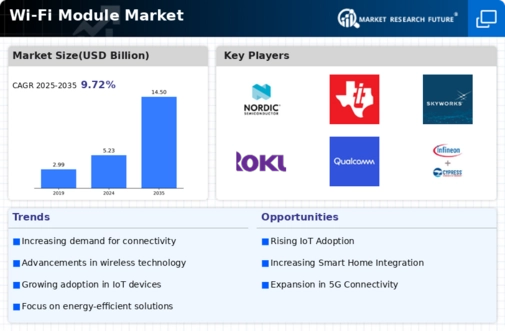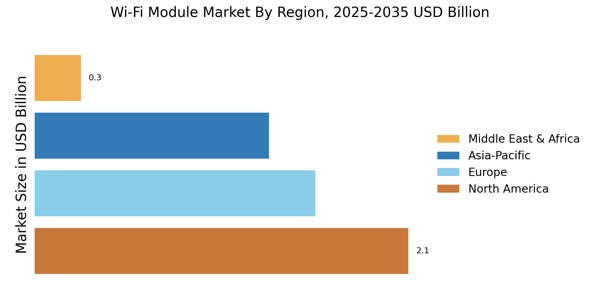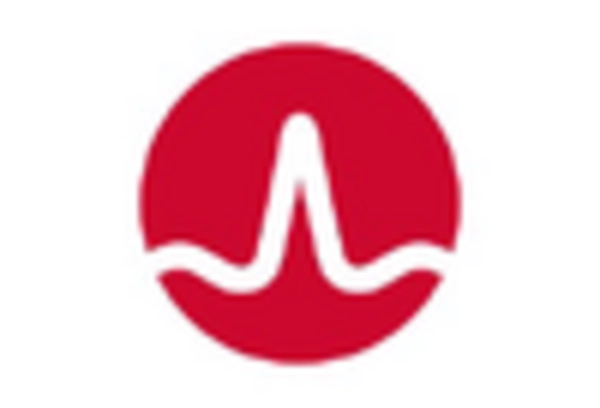Emergence of 5G Technology
The emergence of 5G technology is poised to have a transformative impact on the Wi-Fi Module Market. As 5G networks roll out, they promise to deliver unprecedented speeds and lower latency, which could redefine how Wi-Fi modules are designed and utilized. The integration of 5G with Wi-Fi technology may lead to hybrid solutions that enhance connectivity options for users. This convergence is likely to create new opportunities for manufacturers to innovate and develop advanced Wi-Fi modules that can seamlessly operate alongside 5G networks. As such, the Wi-Fi Module Market stands to benefit from the advancements brought about by 5G technology, potentially leading to increased market growth.
Growing Focus on Smart Cities
The growing focus on smart cities is a significant driver of the Wi-Fi Module Market. As urban areas increasingly adopt smart technologies to improve infrastructure and services, the demand for reliable Wi-Fi connectivity becomes essential. Smart city initiatives often involve the deployment of sensors, cameras, and other IoT devices that require robust Wi-Fi modules for data transmission and communication. Reports suggest that investments in smart city projects are expected to reach trillions of dollars in the coming years. This trend underscores the necessity for advanced Wi-Fi modules that can support the complex networks required for smart city applications, thereby fostering growth in the Wi-Fi Module Market.
Expansion of Smart Home Technologies
The expansion of smart home technologies is significantly influencing the Wi-Fi Module Market. As more households adopt smart devices such as thermostats, security cameras, and lighting systems, the reliance on Wi-Fi connectivity becomes paramount. Reports indicate that the smart home market is projected to grow at a compound annual growth rate of over 25% in the coming years. This growth necessitates the integration of efficient Wi-Fi modules that can support multiple devices simultaneously without compromising performance. As a result, manufacturers are increasingly focusing on developing Wi-Fi modules that cater specifically to the needs of smart home applications, thereby driving the Wi-Fi Module Market forward.
Rising Demand for High-Speed Internet
The increasing demand for high-speed internet connectivity is a primary driver of the Wi-Fi Module Market. As consumers and businesses alike seek faster and more reliable internet access, the need for advanced Wi-Fi modules has surged. According to recent data, the number of internet users has reached approximately 5 billion, with a significant portion relying on wireless connections. This trend is further fueled by the proliferation of smart devices, which require robust Wi-Fi capabilities to function optimally. Consequently, manufacturers are compelled to innovate and enhance their Wi-Fi modules to meet these escalating demands, thereby propelling the growth of the Wi-Fi Module Market.
Increased Adoption of Wireless Communication
The increased adoption of wireless communication technologies is a crucial factor propelling the Wi-Fi Module Market. With the shift towards wireless solutions in various sectors, including healthcare, education, and retail, the demand for Wi-Fi modules has escalated. For instance, the healthcare sector is increasingly utilizing wireless technologies for patient monitoring and data transmission, which necessitates reliable Wi-Fi connectivity. Furthermore, the retail industry is leveraging Wi-Fi for customer engagement and inventory management. This widespread adoption of wireless communication solutions indicates a robust growth trajectory for the Wi-Fi Module Market, as businesses seek to enhance operational efficiency and connectivity.
















Leave a Comment